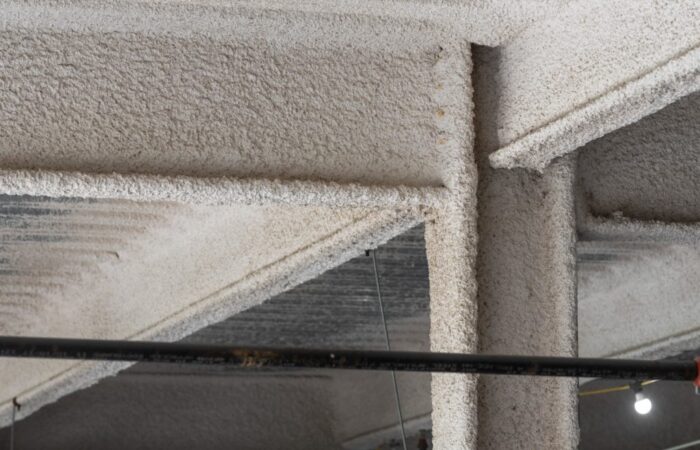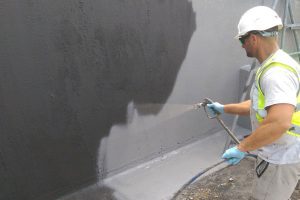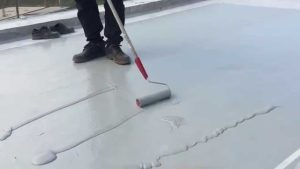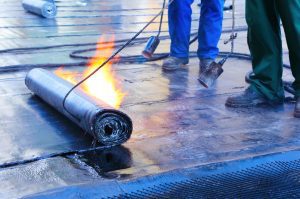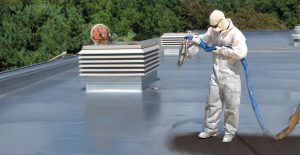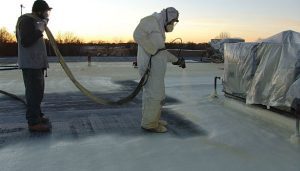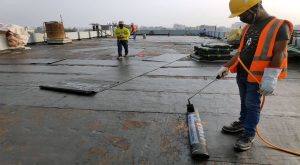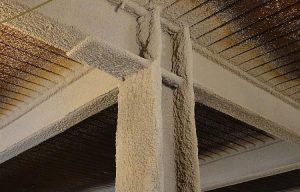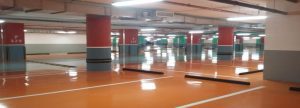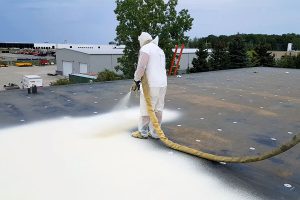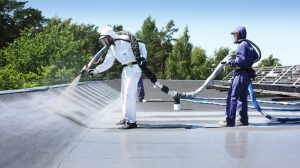Fireproofing of Steel Structure
Book Introduction:
In today’s world, where infrastructure is becoming more complex and advanced, the use of steel structures has become more common. With their durability and strength, steel structures are preferred in various industries. However, they are also vulnerable to fire and can lose their strength and integrity in case of fire accidents. To mitigate the risk of fire damage to steel structures, fireproofing has become a crucial aspect of their design and construction.
The book “Fireproofing of Steel Structure” provides a comprehensive guide on the various methods of fireproofing and their applications in different industries. The book covers both passive and active fire protection techniques that can be used to protect steel structures from fire damage.
The book begins with an overview of the basics of steel structures and the risk of fire damage to them. It then delves into the various methods of fireproofing, including intumescent coatings, cementitious coatings, fire-resistant boards, and sprays. The book also covers the design and installation of fireproofing systems, as well as inspection and maintenance practices.
Each chapter of the book covers a specific aspect of fireproofing, including the science behind fireproofing materials, their properties, and their application methods. The book also includes case studies of successful fireproofing applications in various industries, including oil and gas, chemical, and transportation.
Book Introduction:
Fire is one of the most destructive forces in nature. When a fire breaks out in a building, it can quickly spread and cause extensive damage. This is especially true in steel structures, where the high temperatures can cause the metal to weaken and collapse. The consequences of a fire in a steel structure can be catastrophic, leading to property damage, injury, and even loss of life.
To prevent these devastating outcomes, fireproofing of steel structures is critical. Fireproofing is the process of applying materials to steel structures to prevent or delay the spread of fire. The goal of fireproofing is to protect the structure, as well as the occupants and contents inside.
In this book, we will explore the various aspects of fireproofing of steel structures. We will discuss the history of fireproofing, the different types of fireproofing materials, the application methods, and the standards and regulations that govern fireproofing. We will also examine some of the challenges and considerations when designing and implementing a fireproofing system.
We will delve into the different types of fire protection systems, including passive and active fire protection. We will explore the importance of proper fire detection and suppression systems and how they work in conjunction with fireproofing to provide a comprehensive approach to fire protection.
In addition, we will examine some of the common misconceptions and myths surrounding fireproofing, as well as the limitations and challenges that come with fireproofing of steel structures. We will also discuss the future of fireproofing, including emerging technologies and techniques that have the potential to improve the effectiveness and sustainability of fireproofing.
By the end of this book, readers will have a solid understanding of fireproofing of steel structures and the importance of a comprehensive approach to fire protection. They will be equipped with the knowledge to make informed decisions about fireproofing systems and ensure the safety of their structures and occupants.
Chapter 1: History of Fireproofing of Steel Structures
Fireproofing of steel structures has a long and fascinating history. The earliest attempts at fireproofing can be traced back to ancient civilizations, where builders used materials like clay, mud, and animal hair to protect their structures from fire.
In the 19th century, steel became a popular building material due to its strength and durability. However, it quickly became apparent that steel was highly susceptible to fire damage. This led to the development of various fireproofing methods, including the use of concrete and asbestos.
In the early 20th century, the first building codes and standards for fireproofing were introduced. These codes required buildings to have fire-resistance ratings, which were based on the amount of time a building could withstand fire without collapsing.
Over the years, fireproofing materials and methods have continued to evolve. Asbestos, which was once a popular fireproofing material, has been largely phased out due to health concerns. Today, there are a variety of materials used for fireproofing, including intumescent coatings, cementitious coatings, and mineral fiber insulation.
Despite these advancements, fires in steel structures continue to occur. The causes of these fires can be varied, ranging from electrical faults to human error. However, with proper fireproofing systems in place, the damage and consequences of these fires can be minimized.
In the following chapters, we will explore the different types of fireproofing materials and methods in more detail, as well as the standards and regulations that govern fireproofing of steel structures. We will also examine the various types of fire protection systems and how they work in conjunction with fireproofing to provide comprehensive protection against fire.
Chapter 1: Introduction to Steel Structures
This chapter provides an overview of steel structures, their properties, and their applications in various industries. The chapter also discusses the risk of fire damage to steel structures and the importance of fireproofing.
Chapter 2: Fundamentals of Fire
This chapter covers the science of fire, including its properties, behavior, and causes. The chapter also discusses the different types of fires and their characteristics.
Chapter 2: Types of Fireproofing Materials
There are several types of materials that can be used for fireproofing of steel structures. Each material has its own advantages and disadvantages, and the choice of material depends on factors such as the level of fire protection required, the cost, and the application method.
Intumescent coatings are one of the most commonly used fireproofing materials for steel structures. Intumescent coatings are paint-like materials that expand and form a thick, protective layer when exposed to fire. This layer acts as an insulator, protecting the steel from the high temperatures of the fire. Intumescent coatings are typically applied in multiple layers to achieve the desired level of fire protection.
Cementitious coatings are another popular fireproofing material for steel structures. These coatings are made from a mixture of cement, aggregates, and fibers, and are typically applied by spraying or troweling. Cementitious coatings provide a hard, durable surface that can withstand high temperatures and impact, making them suitable for use in harsh environments.
Mineral fiber insulation is a type of fireproofing material that is typically used in industrial settings. This material is made from a blend of natural and synthetic fibers, and is designed to resist heat and flames. Mineral fiber insulation can be applied by spraying, troweling, or pouring, and is often used to insulate pipes and ducts.
Other fireproofing materials include vermiculite and perlite, which are lightweight aggregates that can be mixed with cement to create a fireproofing material. These materials are often used in conjunction with other fireproofing methods to provide additional protection.
In the following chapters, we will explore each of these fireproofing materials in more detail, including their advantages, disadvantages, and application methods.
Chapter 3: Methods of Fireproofing
This chapter delves into the various methods of fireproofing, including intumescent coatings, cementitious coatings, fire-resistant boards, and sprays. The chapter discusses the properties of each method and their applications in different industries.
Chapter 3: Application Methods for Fireproofing Materials
The application method used for fireproofing materials depends on the type of material being used, as well as the size and shape of the steel structure. There are several common application methods used for fireproofing of steel structures, including spraying, troweling, and pouring.
Spraying is one of the most commonly used application methods for fireproofing materials. This method involves spraying the fireproofing material onto the steel structure using specialized equipment. Spraying is often used for intumescent coatings and cementitious coatings, as it allows for a smooth, even application.
Troweling is another common application method for fireproofing materials. This method involves applying the fireproofing material using a trowel or spatula. Troweling is often used for cementitious coatings, as it allows for precise application in hard-to-reach areas.
Pouring is a less common application method for fireproofing materials, but is often used for mineral fiber insulation. This method involves pouring the fireproofing material into place and then allowing it to set.
In addition to these application methods, some fireproofing materials can also be pre-fabricated and installed onto the steel structure like a panel. This method is often used for insulation blankets and other types of prefabricated fireproofing systems.
The choice of application method depends on a variety of factors, including the type of fireproofing material being used, the size and shape of the steel structure, and the level of fire protection required. In the following chapters, we will examine each of these application methods in more detail, including their advantages, disadvantages, and best practices for installation.
Chapter 4: Intumescent Coatings
This chapter focuses on intumescent coatings, which are a popular method of fireproofing. The chapter covers the science behind intumescent coatings, their properties, and their application methods.
Chapter 5: Cementitious Coatings
This chapter covers cementitious coatings, another popular method of fireproofing. The chapter discusses the science behind cementitious coatings, their properties, and their application methods.
Chapter 4: Standards and Regulations for Fireproofing of Steel Structures
In order to ensure the effectiveness and safety of fireproofing systems, there are several standards and regulations that govern fireproofing of steel structures. These standards and regulations are designed to provide guidance on the appropriate types of fireproofing materials and application methods, as well
Chapter 6: Fire-resistant Boards
This chapter covers fire-resistant boards, which are often used in passive fire protection. The chapter discusses the properties of fire-resistant boards, their installation methods, and their applications in different industries.
Chapter 7: Sprays
This chapter covers spray fireproofing, which is a versatile method of fire protection. The chapter discusses the science behind spray fireproofing, its properties, and its application methods.
Chapter 8: Design and Installation of Fireproofing Systems
This chapter covers the design and installation of fireproofing systems. The chapter discusses the different factors that must be considered in designing fireproofing systems and the various installation methods.
Chapter 9: Inspection and Maintenance of Fireproofing Systems
This chapter covers the inspection and maintenance of fireproofing systems. The chapter discusses the importance of regular inspections and maintenance to ensure the continued effectiveness of fireproofing systems.
Chapter 9: Testing and Inspection of Fireproofing
Testing and inspection of fireproofing materials is crucial to ensuring their effectiveness and longevity. It is also important to ensure that the fireproofing has been applied properly and in accordance with the manufacturer’s specifications. In this chapter, we will discuss the testing and inspection procedures that should be followed for fireproofing of steel structures.
9.1 Non-Destructive Testing
Non-destructive testing (NDT) is the process of evaluating materials or structures without causing damage to them. NDT is a critical part of the testing and inspection process for fireproofing because it allows for an accurate assessment of the integrity of the fireproofing material without causing any damage to it. Common NDT methods include ultrasonic testing, radiography, and magnetic particle inspection.
Ultrasonic testing involves the use of high-frequency sound waves to detect flaws or defects in a material. This method is commonly used to test the thickness of fireproofing coatings. Radiography involves the use of X-rays or gamma rays to inspect materials for flaws or defects. This method is commonly used to inspect the integrity of steel components and to ensure that the fireproofing has been applied properly.
Magnetic particle inspection involves the use of magnetic fields to detect flaws or defects in a material. This method is commonly used to inspect welds and other steel components for cracks or other defects.
9.2 Destructive Testing
Destructive testing is a more invasive method of testing that involves the removal of a sample of the fireproofing material for analysis. This method is used to determine the composition and properties of the material, as well as to evaluate its resistance to fire and other environmental factors.
One common destructive testing method is the ASTM E119 fire test. This test involves subjecting a sample of the fireproofing material to a standardized fire for a set period of time and evaluating its performance. Another destructive testing method is the ASTM E84 test, which evaluates the flame spread and smoke development of the material.
9.3 Inspection
Inspection of fireproofing is important to ensure that it has been applied properly and is in good condition. Regular inspection can help identify areas that may require maintenance or repair before a fire occurs.
Inspection should be carried out by qualified personnel who have experience in the inspection of fireproofing materials. During the inspection, the inspector should look for signs of damage, wear, or corrosion on the fireproofing material. They should also check for areas where the fireproofing has been removed or damaged, as well as any gaps or voids in the material.
In addition to visual inspection, it is also important to use NDT methods to assess the condition of the fireproofing material. Ultrasonic testing can be used to check the thickness of the coating, while radiography can be used to check for any damage or defects in the steel components.
Conclusion
Testing and inspection are critical to ensuring the effectiveness and longevity of fireproofing materials. By following the proper testing and inspection procedures, it is possible to identify areas that may require maintenance or repair before a fire occurs, and to ensure that the fireproofing has been applied properly and is in good condition. It is important to use qualified personnel for inspection and to follow the manufacturer’s specifications for testing and inspection.
Chapter 10: Case Studies – Oil and Gas Industry
This chapter provides case studies of successful fireproofing applications in the oil and gas industry. The chapter discusses the different fire hazards in the industry and the fireproofing methods that have been used to mitigate the risks.
Chapter 10: Maintenance of Fireproofing
Maintenance of fireproofing is essential to ensure its continued effectiveness in protecting steel structures from fire. Over time, fireproofing can become damaged, degraded, or removed, and it is important to regularly inspect and maintain the fireproofing to ensure that it is in good condition. In this chapter, we will discuss the key aspects of fireproofing maintenance.
10.1 Regular Inspection
Regular inspection is a crucial part of fireproofing maintenance. Inspection should be carried out by qualified personnel who have experience in the inspection of fireproofing materials. During the inspection, the inspector should look for signs of damage, wear, or corrosion on the fireproofing material. They should also check for areas where the fireproofing has been removed or damaged, as well as any gaps or voids in the material.
In addition to visual inspection, it is also important to use NDT methods to assess the condition of the fireproofing material. Ultrasonic testing can be used to check the thickness of the coating, while radiography can be used to check for any damage or defects in the steel components.
10.2 Repair and Replacement
If any damage or degradation is found during the inspection, it is important to repair or replace the fireproofing material as soon as possible. Repair may involve patching or recoating the damaged area, while replacement may involve removing the damaged fireproofing material and applying a new coating.
It is important to use the same type of fireproofing material and application method as the original material to ensure that the fire protection is consistent throughout the structure. If the original material is not available or is no longer manufactured, a suitable replacement material should be selected and tested to ensure its effectiveness.
10.3 Maintenance Schedule
To ensure that fireproofing maintenance is carried out regularly and in a timely manner, it is important to establish a maintenance schedule. The schedule should specify the frequency of inspections and maintenance activities, as well as the personnel responsible for carrying out the activities.
The maintenance schedule should take into account the environmental conditions that the fireproofing is exposed to, as well as the type of fireproofing material and its expected lifespan. For example, if the structure is located in a corrosive environment, more frequent inspections and maintenance may be required to ensure that the fireproofing is not degraded by corrosion.
Conclusion
Regular inspection, repair, and replacement are crucial to maintaining the effectiveness of fireproofing in protecting steel structures from fire. It is important to establish a maintenance schedule that takes into account the environmental conditions and expected lifespan of the fireproofing material. By following the proper maintenance procedures, it is possible to ensure that the fireproofing remains in good condition and continues to provide effective fire protection for the structure.
This chapter provides case studies of successful fire
The chemical industry involves the use of various hazardous chemicals, which can increase the risk of fire accidents. In this chapter, we will explore the different fireproofing methods used in the chemical industry to protect steel structures.
One of the commonly used fireproofing methods in the chemical industry is intumescent coatings. Intumescent coatings are often used to protect steel structures from hydrocarbon fires. These coatings swell when exposed to high temperatures, forming a char layer that insulates the steel from the heat. This protects the steel from losing its strength and integrity during a fire.
Cementitious coatings are also used in the chemical industry to protect steel structures. These coatings are highly resistant to chemical attack and can provide excellent fire protection. Cementitious coatings are often used in conjunction with intumescent coatings to provide a comprehensive fireproofing solution.
Another fireproofing method used in the chemical industry is the use of fire-resistant boards. These boards are made from mineral wool or glass fibers and can withstand high temperatures. They are often used to protect the structural steel supports of equipment that contains hazardous chemicals.
Spray fireproofing is also used in the chemical industry to provide fire protection. Sprays are often used in hard-to-reach areas where other fireproofing methods are not suitable. Spray fireproofing can be applied to irregular surfaces and can provide excellent thermal insulation.
In this chapter, we will provide case studies of successful fireproofing applications in the chemical industry. These case studies will highlight the different fireproofing methods used and their effectiveness in protecting steel structures from fire damage.
Overall, fireproofing is an essential aspect of protecting steel structures in the chemical industry. The use of appropriate fireproofing methods can help reduce the risk of fire damage and ensure the safety of personnel working in the industry.

